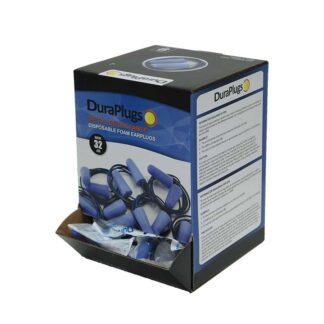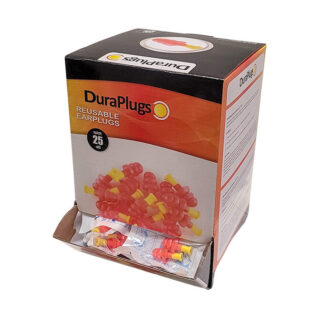Hearing Protection
Many environments inside and out involve hazardously loud noises and distractions. Exposure over time can have long-term effects. That’s why choosing the proper hearing protection is essential. Liberty Safety offers quality hearing protection solutions from DuraPlugs™. From earmuffs to ear plugs, each is designed to provide reliable protection and be comfortable in any work environment.
Many environments inside and out involve hazardously loud noises and distractions. Exposure over time can have long-term effects. That’s why choosing the proper hearing protection is essential.
Liberty Safety offers quality hearing protection solutions from DuraPlugs™. From earmuffs to ear plugs, each is designed to provide reliable protection and be comfortable in any work environment.
Showing all 9 results
-
 1425Y
1425YDuraPlugs™
Adjustable Headband Ear Muff

-
 14421
14421DuraPlugs™
Banded Earplugs

-
 14311
14311DuraPlugs™
Foam - Corded

-
 14321
14321DuraPlugs™
Foam - Metal Detectable

-
 14322
14322DuraPlugs™
Foam - Metal Detectable

-
 14310
14310DuraPlugs™
Foam - Uncorded

-
 1437Y
1437YDuraPlugs™
Foldable Ear Muffs

-
 14271
14271DuraPlugs™
Reusable Ear Plugs - Corded

-
 14270
14270DuraPlugs™
Reusable Ear Plugs - Uncorded

FAQ
Hearing protection is required in work environments that are exposed to noise levels equal to or
greater than 85 decibels (dB) averaged over an eight-hour period. It is critical to know what type and level of noise you will be exposed to before choosing the appropriate hearing protection devices.
There are several sound-measuring instruments to measure the noise levels in a workspace. These include sound level meters, noise dosimeters, and octave band analyzers.
OSHA notes that noise may be a problem in your workplace if you:
- Hear ringing or humming in your ears when you leave work.
- Have to shout to be heard by a coworker an arm’s length away.
- Experience temporary hearing loss when leaving work.
The National Institute for Occupational Safety and Health (NIOSH) Sound Level Meter App is one tool available to the public to download on mobile iOS devices that measure sound levels in the workplace and provide noise exposure parameters to help reduce occupational noise-induced hearing loss.
The OSHA standard 1910.95(b)(1) says that when employees are subjected to sounds over 85 decibels (dB), then administrative or engineering controls should be put in place. If that doesn’t reduce sound levels, then hearing protection needs to be provided to limit the sounds levels.
Not only will a few decibels bring down the risk of permanent hearing loss but it also improves communication and noise-related annoyance.
OSHA defines Hearing Protective Devices (HPDs) as the earmuffs and ear plugs used when other control measures aren’t available to reduce exposures to noise.
To measure HPDs effectiveness, the American National Standards Institute (ANSI) developed ANSI S3.19 as a way to calculate rates of noise reduction capabilities for each device. It’s a method that uses what they call a “Noise Reduction Rating” (NRR), which is a unit of measurement represented in decibels.
To ensure a device offers the correct level of hearing protection, it must be tested properly and clearly labeled with the ANSI S3.19 standard number showing their potential to reduce noise in decibels (dB).
For hearing protection requirements, the OSHA regulation [29 CFR 1910.95(i)(1)] states that:
Employers shall make hearing protectors available to all employees exposed to an eight-hour time-weighted average of 85 decibels or greater at no cost to the employees. Hearing protectors should be replaced as necessary.
Additional regulations from OSHA that are under 1910.95(i) are:
- Employees shall be allowed to select their hearing protectors from a variety of suitable hearing protectors provided by the employer.
- The employer shall provide training in the use and care of all hearing protectors provided to employees.
- The employer shall ensure proper initial fitting and supervise the correct use of all hearing protectors.
The best hearing protector is the one that is comfortable and convenient and one that you will wear every time you are in an environment with hazardous noise. So, you’ll want to choose hearing protection based on performance, selection, care, and use.
Single-Use Ear Plugs are easy-to-use and ranging in different attenuation ratings. These disposable foam ear plugs provide the right fit for every user. Products are available in corded or uncorded styles.
Reusable Ear Plugs have a unique three-flange design for a better seal in the ear canal providing protection. The firm stem facilitates easy insertion and removal and increased comfort for long-term wear. Products are available in corded or uncorded styles.
Detectable Ear Plugs have a small piece of metal attached to the ear plugs themselves or built into the cord. The purpose is when the product is screened for final inspection the screeners are able to locate it and avoid contamination. Products are available in single-use and multiple-use styles.
Banded Ear Plugs consist of two ear plugs held over the ends of the ear canal by a rigid headband. These types of ear plugs create less bulk for easy don and doff.
Ear Muffs are made from sound-attenuating materials and padded ear cups for a secure fit without compromising comfort.
Showing all 9 results
